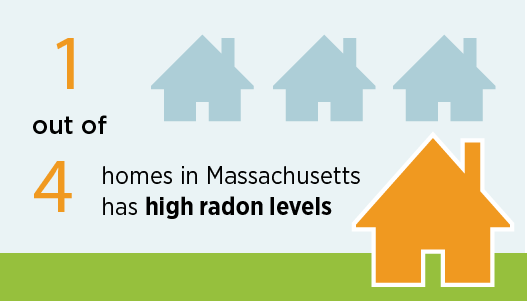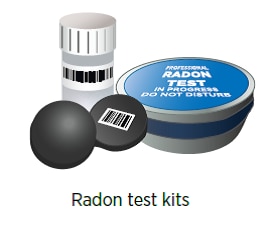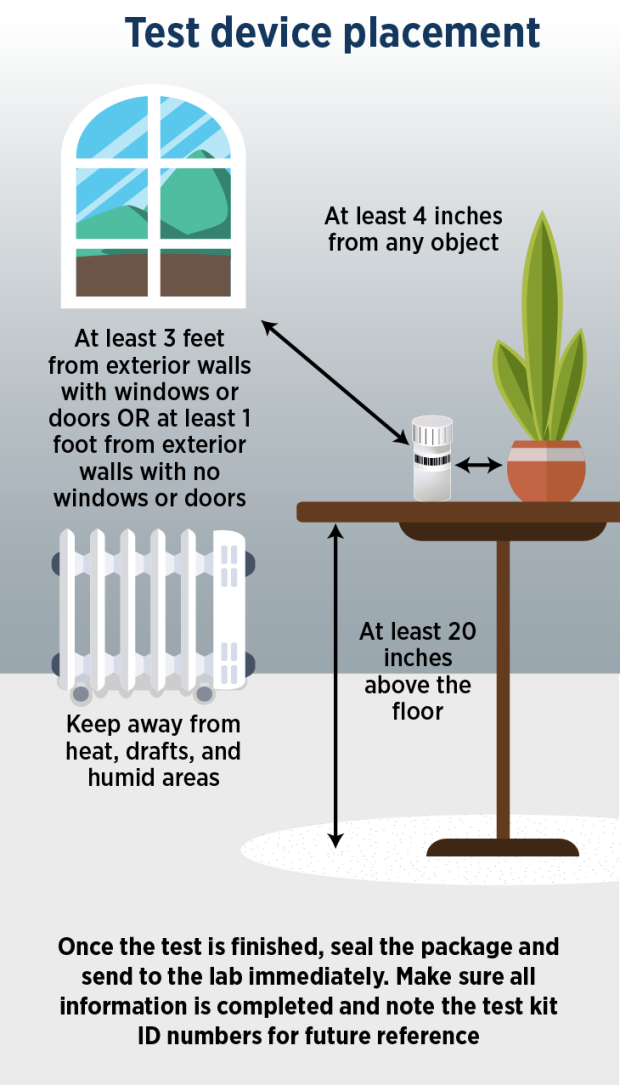What is radon?
Radon is a radioactive gas that comes naturally from soil and rocks. You can’t see, taste, or smell radon. Radon can build up inside your house and cause lung cancer if you breathe it in over many years. Any home can have a radon problem, no matter the foundation type. Testing your home is the only way to know if radon is a problem. Everyone should test their home for radon.
How do I test for radon?
To screen your home for radon, you can:
- Buy a radon test kit from a home improvement store
- Hire a radon measurement specialist certified by either the National Radon Safety Board or the American Association of Radon Scientists and Technologists - National Radon Proficiency Program
- If you are a homeowner or renter who would like to test your home for the first time, you can call the Massachusetts Department of Public Health’s radon information line at (800) 723-6695 for a free radon test kit during the heating season (November through March).
What do my test results mean?
Radon in the air is measured in "picocuries per liter of air" or pCi/L. The level of radon in outdoor air is about0.4 pCi/L. No home will have 0 pCi/L.
The U.S. Environmental Protection Agency (EPA) has set the 'action level" for radon at 4 pCi/L. You should fix (“mitigate”) your home if radon is above the action level. No level of radon is risk-free, so the EPA recom- mends you consider action if your home’s radon level is between 2 and 4 pCi/L.
What if I have a radon mitigation system?
If you have a mitigation system, be sure to test your system every year or two to make sure the system is operating properly. A system that is incorrectly designed or installed can make the problem worse.
Contact the Massachusetts Radon Hotline at (800) 723-6695 if you have questions about radon and testing. The Massachusetts Department of Public Health has also developed a fact sheet for “Fixing Radon in your Home” as well as a general fact sheet for homes and one for health care providers. These are available at www.mass.gov/radon.
Do’s and Don'ts of Testing Your Home for Radon
Follow these tips to make sure your radon test is accurate.
Things to DO before a test:
- Read all instructions that come with your test kit.
- Test between November 1 and March 31. Radon levels are typically higher in the winter. Re-test your home if your first test was in summer.
- If you are doing a short-term test lasting 2 or 3 days, close your windows and outside doors for at least 12 hours before beginning the test. Keep outside doors closed as much as possible during the test.
Things to DO during a test:
- Operate heating and air conditioning system fans that re-circulate air during the test.
- Place the test kit in the lowest level of the home where people spend time (such as a living room, playroom, den, or bedroom).
- Place the test kit in a location where it won’t be disturbed:
- On a flat surface (such as a table) and at least 20 inches above the floor
- 1 foot away from an exterior wall, and 3 feet away from any exterior wall with openings (such as doors or windows)
- 4 inches away from any other object
- Away from any drafts, heat, or humidity (such as a washer or dryer)
- Leave the kit in place for as long as the package says
During a test, DON’T:
- Don’t operate whole-house fans that bring in air from the outside.
- Don’t operate fireplaces.
- Don’t place the test kit in your kitchen, laundry room, bathroom, or closet.
- Don’t test during storms, high wind (greater than 30 miles per hour) conditions, or unseasonably warm weather
Things to DO after a test:
- Write down the test kit ID number for future reference.
- Reseal the package. Fill in forms that come with the test and send it promptly to the lab specified on the package. You should receive your test results within a few weeks.
For additional questions on radon, obtaining a free test kit, or radon mitigation, contact the Massachusetts Radon Unit by calling 800-723-6695 (toll-free in MA)
Additional Resources
-
Open PDF file, 428.11 KB, Testing Your Home for Radon (English, PDF 428.11 KB)
Contact
Online
Phone
or
The operating hours are Mondays through Fridays from 8:45 a.m.-5 p.m. Please leave a message including your phone number and you will receive a call back.


